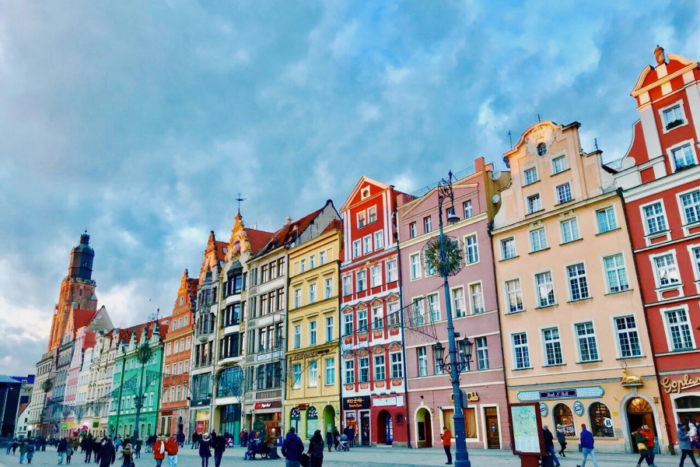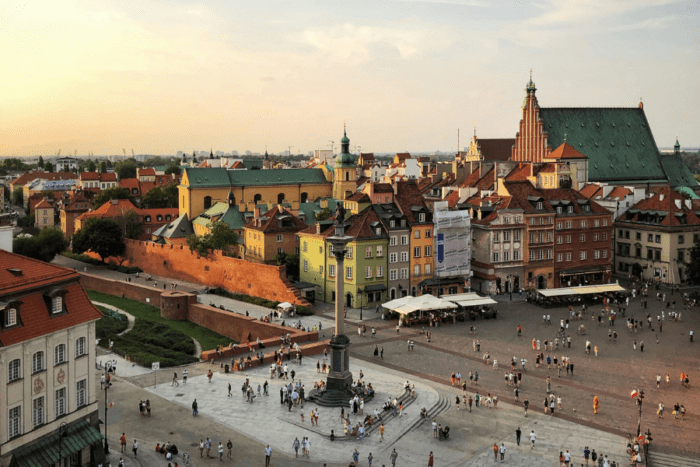Poland Citizenship by Descent and Marriage
June 6, 2024
If modernity fused with tradition is your ‘thing’ then Poland is a country you don’t want to miss out on.
This union is evident from the moment you arrive at Warsaw’s Chopin Airport. More than a gateway to Poland, Chopin is a symbol – a vision of sleek contemporary architecture blending seamlessly with a rich historical legacy.
Beyond the international airport, Warsaw, a capital city once devastated by war, has risen like a phoenix, embodying resilience and renewal. Towering skyscrapers stand shoulder to shoulder with meticulously restored historical buildings but above them all, the iconic Palace of Culture and Science dominates the skyline, a symbol of the city’s enduring spirit and a perfect introduction to Warsaw’s eclectic character.
It doesn’t sound like a bad place to start your search for a second passport, does it?
Imagine connecting with your heritage and gaining access to a range of new opportunities by becoming a Polish citizen. Whether you’re seeking to embrace your ancestral roots or taking advantage of marital ties, understanding the pathways to Polish citizenship can open up a world of possibilities.
This comprehensive analysis will explore the two primary routes to Polish citizenship: by descent and by marriage, providing you with the essential information to get started.
If you can prove that you have Polish parents, grandparents or even great-grandparents, you might be eligible for Polish citizenship. The Polish government recognises the principle of ‘jus sanguinis’ (right of blood), which means that, if your ancestors were Polish citizens, you might inherit this right.
The process involves thorough documentation and verification, making it essential to gather all relevant birth, marriage, and death certificates, alongside any other legal documents that trace your lineage back to a Polish citizen.
On the other hand, acquiring Polish citizenship through marriage is a pathway available to those who have tied the knot with a Polish national. While seemingly straightforward, this route requires meeting several legal requirements and a residency period.
Typically, after residing in Poland for a specified period and demonstrating a stable marriage, you can apply for citizenship. It’s important to note this process not only emphasises your marital status but also your integration into Polish society, including language proficiency and cultural understanding.
Neither option is simple. Poland has fought tirelessly to exist and profound national pride influences just about everything here. So it’s hardly a surprise that Poland takes a rigorous approach when it comes to granting citizenship.
As a result, navigating the legal landscape of acquiring Polish citizenship can be daunting. Still, with the right guidance and preparation, it is entirely achievable. That’s where Nomad Capitalist comes in – by understanding the specific criteria and documentation required for each pathway, you can streamline your application process.
Poland’s Citizenship-by-Descent Program

Citizenship by descent (CBD) in Poland primarily caters to those with direct Polish lineage. The process isn’t merely a bureaucratic afterthought – it’s rooted in historical and blood ties to Polish soil and represents an opportunity for individuals to delve into their familial past and reforge connections with their ancestral homeland.
Poland takes CBD seriously so this route isn’t universally accessible. It’s reserved for those whose familial roots are deeply embedded in the country and stands as a testament to Poland’s commitment to preserving its lineage.
In contrast to the closed nature of its descent-based citizenship, Poland offers alternative pathways to citizenship and residence. Those options extend an invitation to those outside its ancestral lineage to partake in the nation’s ongoing narrative. Such avenues, while more accommodating, still reflect Poland’s enduring connection to the past.
But if you do qualify for Poland’s rather rigorous CBD program, you can begin reconnecting with the people of your ancestry. Think about how much more meaningful it will be to celebrate Mass in a small-town chapel or honour the fallen of Warsaw on August 15, as you stand with your fellow countrymen.
That’s one of the main perks of CBD in Poland. You can stand with those around you as a fellow countryman rather than a foreigner.
How to Qualify for Polish Citizenship by Descent

Whether through descent or alternative means, gaining Polish citizenship is a significant undertaking.
An individual qualifies for Polish CBD by tracing their last, native-born, Polish ancestor to their grandfather. If this grandfather did not renounce or lose his citizenship or lost it/renounced it after his spouse gave birth to his children, then the applicant can claim citizenship by descent through this ancestor.
Conversely, if this ancestor lost or renounced his citizenship before having his children, then his citizenship status was not passed on to his children or grandchildren. This means the applicant cannot claim this ancestor as a link to the Polish nation.
There are no limits or strict time restrictions on how far back the applicant can claim ancestral ties. This means the applicant can go back several generations as long as they can demonstrate that each ancestor’s citizenship status remained unbroken, at least until after their children were born. There are a few notable exceptions to this rule, however, including the following scenarios:
- The ancestor was born before 1951: if the ancestor was born in Poland before 1951, several factors could inhibit the applicant’s connection to the ancestor and the claim of Polish roots:
- First, before 1951, Poland did not accept dual citizenship (it does now). This means if your ancestor emigrated to another country and obtained citizenship there in 1950, they had to renounce their Polish citizenship. Even if they never officially renounced it, Poland did not accept people holding two citizenships, so their original Polish citizenship was automatically renounced.
- There were also more restrictions on women at this time. If a woman married a man who was not Polish or who possessed a different citizenship, she automatically acquired his citizenship. This meant, originally, you could not claim citizenship through a female ancestor born before 1951 if she lost her citizenship when she married. But this is changing, giving applicants the ability to use female, as well as male, ancestry for CBD approval.
- Only children born within wedlock or in legally recognised marriages automatically gained Polish citizenship. Children born outside of wedlock before 1951 did not gain the citizenship of their father unless their father accepted them as their child within a year of their birth. In these situations, children acquired the citizenship of the mother. The child would only gain citizenship in Poland if their mother were Polish.
- If the ancestor served in a foreign military, their citizenship would have been revoked, and so an applicant would be unable to claim ancestral ties through this ancestor. However, Poland usually makes exceptions for citizens who served with the allied forces during World War II.
- Modern borders do not apply in the past: Poland’s borders have changed over the years due to conflicts, warfare and other disputes but Poland will recognise these old borders when considering your CBD application. Essentially, this rule implies that applicants can claim ancestral ties through an ancestor even if they did not reside in the borders of modern-day Poland. Here are some examples of this rule in practice:
- Ancestors born in Poland while under Russia’s leadership and who emigrated before 1918 may still qualify for citizenship. In this scenario, if the ancestor was born in an area such as Warsaw, they may still be claimed as a Polish ancestor for reasons of citizenship by descent. Their birth in a Polish city indicates their ties to Poland even though it was not an independent state back then. If your ancestors resided in an old territory of Poland before World War II they can still be used, even if this region no longer belongs to Poland. This includes areas like Stanislawow, Warszawski, Okręg, Wojskowy, Wilno and Grodno. If your ancestors were born in these areas before World War II, they may still be used to claim citizenship by descent even though these areas no longer belong to the nation of Poland. However, in these situations, it can be challenging to demonstrate these ancestral ties, meaning there’s a lot of work to be done if following this route.
- Polish citizens who migrated to Israel between 1958 and 1984 and became citizens of the new nation lost their Polish citizenship as a result. Under these circumstances, the applicant may be able to re-acquire their Polish citizenship by declaration.
The most important factor in claiming Polish ancestry is demonstrating an unbroken connection between ancestors. This can be difficult, especially if the ancestor’s hometown was destroyed during World War II. However, there are ways to back up claims of ancestral ties through other documentation, such as baptismal records.
Poland prioritises the return of its people, which is why claiming citizenship by descent is one of the best ways to gain citizenship. Poland wants its people to return and has thus crafted a direct, achievable method for these people to do that.
Other methods, including citizenship by declaration, naturalisation and marriage, take longer and have a higher denial rate. All of these alternative citizenship methods are discussed below but, for now, let’s dive into the required documents and the basic procedure to follow when applying for citizenship by descent.
Documents and Overview of the Process

The process of obtaining citizenship by descent in Poland can be lengthy. It requires the applicant to present strong evidence backing up their claims of ancestral ties to the nation. The applicant must also solidify claims that each ancestor along the line of descent had Polish citizenship when their children were born.
Don’t be surprised or discouraged if the application takes a year to be reviewed and you eventually get a response requesting more proof.
Overview of the process: The first and most important part of the process is establishing your family tree. Be sure to find a direct or qualifying connection that you can use to establish your CBD. The next step to establishing citizenship by descent is to find a good attorney who can help you navigate the complexities of the process. Though you don’t have to have an attorney acting on your behalf, it’s a good way to ensure your application is considered and faces minimal pushback from the authorities.
Establishing your family tree ensures that you have a solid claim to ancestral ties to Poland. Start by crafting an unbroken record of ancestral descent from Poland going back several generations by following these general steps:
- Gather as many official and unofficial documents backing up the claims made through your family tree as possible.
- Gather you and your parents’ documents, including birth certificates, passports (even if expired) and marriage licenses if you are married.
- Have all of these documents translated into Polish if necessary (this includes your documents, your parents’ documentation and other supporting documents that aren’t written in Polish). Have these documents certified by a legal representative or a notary/apostille.
- Pay all fees associated with your application, including processing fees and application fees and await a response.
- Upon receiving a response, either take the next steps to obtain your citizenship or gather supporting documents if requested.
The process may appear rather straightforward on paper, but there is a lot of research that goes into the first stages. Make sure you do more than just a quick Google search.
Verify and back up everything.
You must do your homework and find birth records, gravestones and other vital information that can help you support your ancestral claims. However, some genealogy websites do not perform due diligence, and thus, you could be basing your ancestral claims on shaky ground, which the government will not accept.
Genealogy websites are a good resource but, remember, you can’t use them to support your claims. While these websites may be a good starting point for your research, be prepared to verify and double-check every claim made on them or other online sources.
Documents required and recommended: You must have your own personal identification documents translated and officialised by a legal entity or notary. You must also present similar documentation for your parents and supporting documents for your ancestors that trace the individual through whom you’re claiming ancestral ties to Poland.
As an overview, these are the documents you should expect to provide for your application:
- Your identification documents, including your birth certificate, identification cards and passport – translated into Polish and legally approved if necessary.
- Your marriage licence if you’re married or other documents certifying your marital or civil status.
- Your parents’ birth certificates, passports and Polish passports, if applicable. These documents must also be legalised and translated if they are not in Polish.
- Your parent’s marriage licence or divorce papers.
You may also be required to provide supporting documents, such as:
- Your Polish ancestor(s) passport(s)
- Birth certificates of ancestors
- Baptismal records, if you can find these (not necessary, but these can help)
- Birth and death records (if you can find these, they can help support your claims)
- Marriage licences of your ancestors
- Military service records.
Basically, try to find as much supporting documentation as you can.
For example, if your grandfather renounced or lost his citizenship, but you believe his children were born before this happened, the Polish Government expects you to back up these claims.
If you’re not present in Poland to give evidence and demonstrate your ancestral ties, then give someone on the ground the ability to act on your behalf. You don’t have to renounce your existing citizenship to qualify since the country now allows people to hold dual citizenship.
The entire process can take anywhere from 12 to 24 months to complete. The time frame can increase if you fail to supply adequate supporting documents to justify your claim to citizenship.
Poland’s Citizenship-by-Marriage Program

Poland has a provision that allows people to acquire Polish citizenship even if they do not have Polish ancestry. This can be done by claiming citizenship through their spouse, as long as their spouse holds Polish citizenship, or qualifies for citizenship by descent, and completes the necessary process.
Citizenship through marriage is relatively straightforward, requiring three years of marriage to a Polish citizen. However, this is more than a box-ticking exercise as it signifies a deeper commitment to a shared life in Poland.
Individuals must have been residents of Poland for at least two years and married to their Polish spouse before applying for citizenship. The applicant does not have to be a Polish citizen, but they do need to be legally resident in Poland – you can’t simply apply as a tourist or non-resident.
Your Polish visa must be current, officially issued and renewed on time. If your visa expires, you can only apply once your legal residence is re-established. You must remain in Poland for an uninterrupted period of two years before applying for citizenship and cannot leave the country during this time.
It’s also best that you stay in Poland during the application and review process. If your visa is scheduled to expire before this process is complete, ensure you apply for an extension to your residence permit. Guarantee the application is error-free and all of your documents are valid before applying, which will minimise delays.
Bear in mind that Poland is a traditional country that prioritises its Catholic heritage and beliefs. These beliefs give the nation a more traditional approach to marriage, meaning less traditional ones may be limiting.
Documents and Overview of the Process

The overall process is a little easier for citizenship by marriage than when applying through descent since you don’t have to present as much evidence. The main thing is to ensure you have legal status to be in the country and are in a legally recognised marriage, not just a union or partnership.
Same-sex marriage is not officially recognised by the Polish government. Although the EU courts issued a ruling that nations could not deny residence based on marriage and sexual identity, this does not apply to citizenship. The best course of action here might be to consult with a Polish lawyer about your situation.
As usual, the first step to obtaining citizenship is to contact an attorney to act on your behalf and to file your paperwork. This helps avoid mistakes and navigate the complexities. You must submit your marriage licence with the application and demonstrate you have attained at least an intermediate level of Polish language skills.
Alternative Ways to Obtain Citizenship in Poland
Poland, with its complex tapestry of laws and traditions, offers other avenues for those seeking citizenship beyond marriage or descent. These paths include citizenship by recognition and declaration and each comes with its own intricacies and challenges.
Citizenship by Recognition
This pathway, akin to naturalisation, acknowledges those who have established a tangible presence in Poland, be it through professional endeavours or other forms of substantial engagement with the country. It acknowledges a commitment to Poland that transcends mere physical presence.
Citizenship by Declaration

This isn’t a route we usually recommend as it carries a higher chance of being denied but, nonetheless, it is still a potential route to citizenship even if your parents did not have Polish passports at the time of your birth.
To apply, you’ll need to submit your application to the Polish president and it’s up to their discretion whether your application will be approved. The applicant must gather documents to demonstrate their ancestry and desire to stay and be present in Poland.
These alternative routes to Polish citizenship are for those who have a deep-rooted desire to be part of Poland yet lack straightforward lineage or marital connections.
Residence in Poland
Perhaps you got a taste of Poland during a holiday there, hiking the Tatra Mountains or enjoying the nightlife in Warsaw?
If you wish to return, Poland has plenty of options for those seeking temporary and permanent residence. Those who do not qualify for Polish citizenship can acquire permanent or temporary residence in the country.
Temporary Residence
A temporary residence permit issued to allow individuals to stay in the country for up to three years is usually granted for study or work purposes. It can be for a shorter period if the government deems your reason for staying does not merit a prolonged residence. Although the permit can’t be renewed, you can reapply after three years if you wish to stay longer.
Permanent Residence

Permanent residence is granted after an individual has been living in Poland on a temporary residence status. Therefore, applying for temporary status is the first step to obtaining permanent residence. To qualify, you need to have lived in Poland legally on a temporary residence card for at least five years.
Permanent residency status lasts for an indefinite period, although the residence card needs to be renewed every ten years. One of the main perks with this option is that it allows you to work in the country legally without a permit.
How to Acquire Temporary Residence
The Voivodeship Office in the Foreign Affairs Department is responsible for handling the paperwork and issuing residence cards.
Preparing for submission includes getting notarised copies of all your documents and having them translated, if not written, in Polish. In total, you must submit two copies of the application and the following supporting documents:
- A valid travel document like a passport
- Four coloured photos for your visa
- Proof of stamp duty payment
- Proof of health insurance
- University acceptance letter depending on applicability
- Work permit issued by a Polish employer if applicable
- Proof of residence (even just a signed agreement from the owner).
While you don’t necessarily need to show proof of employment, you should show proof of income or funds. This is to proof to the government that you can financially support yourself.
After submission, be sure to pay any fees applicable to your particular residence application. This includes legal fees and other expenses.
How to Acquire Permanent Residence
To qualify for permanent residence, you must spend at least five years in Poland as a legal temporary resident. Next, you must select the route to take to obtain a permanent residence. This includes:
- Living in Poland consecutively for at least five years on either a work visa, family reunification visa or a student visa
- Being married to a Polish citizen for at least three years
- Demonstrating Polish ancestry and indicating you plan to stay in Poland permanently
- Being granted asylum
- Being a child of a Polish citizen or a permanent resident
- Having a tolerated stay permit granted for at least ten years and being unable to return home because of the threat of violence, persecution or similar circumstances
- Victims of human trafficking may qualify if they have lived in Poland for at least a year and have shown their cooperation with law enforcement.
You must present the following documents translated into Polish when requested:
- A valid travel document like a passport
- Four coloured photos
- Proof of fees/stamp duty payment of approximately €150
- Health insurance certificate.
The Polish government may request further documentation backing up your application. The amount of time it takes for your application to be processed varies, but it usually takes around three months.
While not granting the same rights and privileges in Poland as citizenship, residence may be a good alternative if you fail to qualify.
Regions of Poland and Where to Live

Poland has regions with different characteristics that cater to tastes of all types, including cities, rural regions, open spaces and forests. Gdansk, with its bourgeois architecture, draws tourists all year round while rural retreats boast luxurious spas and resorts. There are 16 different provinces in Poland, each one offering something new and unique.
Mazowieckie Province: Dominated by Warsaw, Poland’s capital, this province melds the historical with the contemporary. The city’s architecture ranges from Gothic churches to neoclassical palaces and modern skyscrapers. The nearby Kampinos National Park provides a stark contrast with dense forests and meandering rivers, representing a haven for nature lovers.
Lubelskie Province: Situated along the Vistula and Bug Rivers, this province is known for its rustic charm. Zamość’s Renaissance Old Town, a UNESCO World Heritage site, and Lublin’s medieval centre stand out for their historical significance and architectural beauty. The province’s national parks, Roztocze and Polesie, are rich in biodiversity.
Podkarpackie Province: Less urbanised and characterised by expansive green landscapes, this province offers a more serene experience. The Carpathian Primeval Forest is a natural treasure, home to a variety of wildlife, including lynxes and wildcats.
Małopolska Province: Famed for the city of Kraków, which is known for its historical and cultural landmarks, this region attracts tourists and expats alike. The Kraków-Częstochowa Upland and the Vistula River Valley offer some of Poland’s most picturesque natural landscapes.
Świętokrzyskie Province: Known for its ancient monastic buildings and the Świętokrzyskie Mountains, this province offers a blend of spiritual reflection and natural beauty. The Świętokrzyski National Park is a must-visit for its pristine trails and scenic vistas.
Podlaskie Province: Known for its unspoiled natural beauty, this province boasts several national parks, including the primaeval Białowieża Forest, a UNESCO World Heritage site. Białystok, the provincial capital, is known for its vibrant culture and welcoming atmosphere.
Warmińsko-Mazurskie Province: This region is a paradise for those seeking tranquillity among its numerous lakes and resort villages. It’s an ideal spot for water sports, fishing or simply enjoying its natural surroundings.
Kujawsko-Pomorskie Province: Home to Toruń, a medieval city recognised by UNESCO, this province is steeped in history. The city’s well-preserved Old Town and Teutonic Knights’ castle are highlights, alongside the region’s ancient Slavic roots.
Pomorskie Voivodship: The home of the Malbork Castle, a massive medieval fortress built by the Teutonic Knights, and lush national forests like Słowiński and Tuchola, this region offers a mix of historical exploration and outdoor adventures.
Wielkopolskie Province: Known as the birthplace of the Polish state, this province is ideal for active lifestyle enthusiasts. The Great Wielkopolska Loop, Wielkopolska National Park and part of Drawa National Park offer ample opportunities for hiking, cycling and water sports.
Opolskie Province: Poland’s smallest province is rich in historical and natural attractions. Its landscape is dotted with castles and lakes, offering a quaint and peaceful setting for visitors.
Dolnośląskie Province: This region boasts diverse natural landscapes, including the Karkonosze and Sowie Mountains, as well as significant historical sites like the Churches of Peace in Jawor and Świdnica and the Centennial Hall in Wrocław, all UNESCO sites.
Lubuskie Province: With Zielona Góra and Gorzów Wielkopolski as its dual capitals, this province is known for its urban vibrancy and green spaces. Park Mużakowski, a UNESCO site, adds to its appeal.
Zachodniopomorskie Province: A coastal region known for its health resorts and spas, offers relaxation and wellness amidst scenic natural surroundings.
Poland Citizenship by Descent & Marriage: FAQs
This depends upon the citizenship path you choose to take. While citizenship by descent is typically the cheapest route, it can be complicated and time-consuming to prove your connection and ties to the country. Time will likely be the most significant investment you make towards Polish citizenship.
Yes, a Polish citizen may hold dual citizenship. Regardless of whether you hold citizenship elsewhere, the Polish government still guarantees your rights as well as responsibilities to the nation.
Yes. Non-nationals can marry Polish citizens and become eligible to apply for Polish citizenship if they wish.
Poland has a rather traditional view of marriage, typically constituting the union of a man and a woman. Other rules include restrictions on women marrying under the age of 18 without permission from a judge and proof that there is nothing prohibiting the marriage.
Yes, but only if you’ve already acquired citizenship. If you divorce before the five years required for permanent residence, you may be forced to leave.
Poland’s residency program usually takes five years. After five years of temporary status in the country, you can apply for permanent residency.
Polish Citizenship Benefits and Privileges

Poland’s unique heritage and close-knit cultural ties are some of the most appealing aspects of its CBD program. If you no longer feel like you fit in back home or are hoping to get yourself a second passport, then seeking out Polish citizenship may be a great option.
When you achieve Polish citizenship or residency, you’ll have the opportunity to better understand the bond that binds the nation and its people. If you qualify for citizenship by descent or marriage, these options can serve as some of the most affordable routes to citizenship. However, the downside is these methods can require a lot of waiting and paperwork.
And that’s where our team at Nomad Capitalist can help. We’ve helped over 1,500 high-net-worth individuals like yourself find ways to go where they’re treated best. Whether you’re hoping to save on taxes, avoid the stress of politics at home or simply want a backup plan in case your home country becomes less favourable to your goals, apply to become a client, and we’ll create your holistic action plan.


How to Get UAE Citizenship – The Complete Guide
Sovereignty – both national and personal – shapes ambition, secures wealth, and defines status in a shifting global order. For the high-achieving global citizen, acquiring a second or even third passport is more than a lifestyle upgrade; it’s a strategic move in long-term financial and geopolitical positioning. But not all citizenships are created equal – […]
Read more

A Gateway to Central Asia: New Kazakhstan Golden Visa Program for 2025
Central Asia just raised the stakes in the golden visa game. In May 2025, Kazakhstan officially launched a 10-year Golden Visa program in an ambitious move to position the country as a serious contender in the global investor migration space. At a time when other international regions are rolling back their citizenship and residency options, […]
Read more

Top Countries Offering Golden Visas in 2025
Residency is no longer about lifestyle – it’s about leverage In an increasingly unpredictable world, Golden Visas offer something most governments can’t: certainty in exchange for capital. They are more than migration tools; they are strategic safeguards offering residence rights, future citizenship, global mobility, and access to tax-friendly jurisdictions. For investors, entrepreneurs and globally minded […]
Read more




